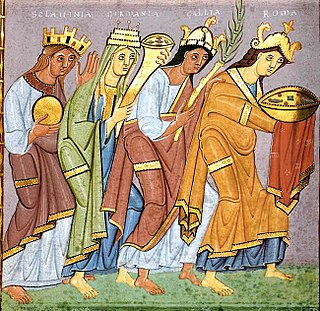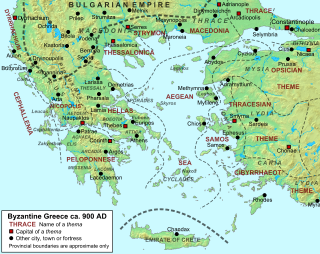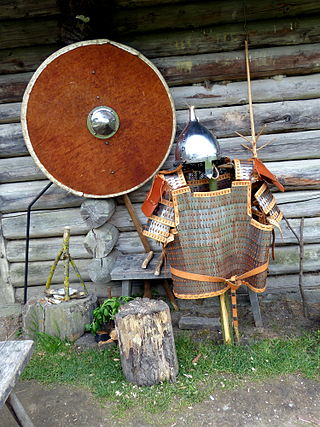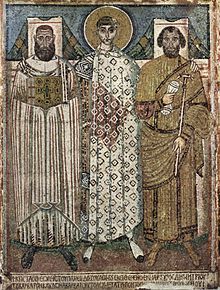
Saint Demetriusof Thessalonica, also known as the Holy Great-Martyr Demetrius the Myroblyte, was a Greek Christian martyr of the early 4th century AD.
The term Unknown Archon,Unknown Prince, or Unnamed Serbian Archon refers to a prince of the Sorbs of the first half of the 7th century who supposedly led his people from their original homeland in White Serbia to settle in the Balkans during the reign of Byzantine Emperor Heraclius (610–641), as mentioned in Emperor Constantine VII's work De Administrando Imperio. The work does not record his name, but states that he was the progenitor of the first Serbian dynasty, and that he died before the arrival of the Bulgars on the Balkans (680), succeeded by his son, and then grandson.

Boril was the emperor (tsar) of Bulgaria from 1207 to 1218. He was the son of an unnamed sister of his predecessor, Kaloyan and Kaloyan's brothers, Peter II and Ivan Asen I, who had restored the independent Bulgarian state. After Kaloyan died unexpectedly in October 1207, Boril married his widow, a Cuman princess and seized the throne. His cousin, Ivan Asen, fled from Bulgaria, enabling Boril to strengthen his position. His other kinsmen, Strez and Alexius Slav, refused to acknowledge him as the lawful monarch. Strez took possession of the land between the Struma and Vardar rivers with the support of Stefan Nemanjić of Serbia. Alexius Slav secured his rule in the Rhodope Mountains with the assistance of Henry, the Latin Emperor of Constantinople.

Dervan or Derwan was an early duke of the Sorbs.

The Sclaveni or Sklabenoi were early Slavic tribes that raided, invaded and settled in the Balkans in the Early Middle Ages and eventually became the progenitors of modern South Slavs. They were mentioned by early Byzantine chroniclers as barbarians having appeared at the Byzantine borders along with the Antes, another Slavic group. The Sclaveni were differentiated from the Antes and Wends ; however, they were described as kin. Eventually, most South Slavic tribes accepted Byzantine or Frankish suzerainty, and came under their cultural influences and Chalcedonian Christianity. The term was widely used as a general catch-all term until the emergence of separate tribal names by the 10th century.
Maurice's Balkan campaigns were a series of military expeditions conducted by Roman Emperor Maurice in an attempt to defend the Balkan provinces of the Roman Empire from the Avars and the South Slavs. Maurice was the only East Roman emperor, other than Anastasius I, who did his best to implement determined Balkan policies during Late Antiquity by paying adequate attention to the safety of the northern frontier against barbarian incursions. During the second half of his reign, the Balkan campaigns were the main focus of Maurice's foreign policies, as a favourable peace treaty with Persian Empire in 591 enabled him to shift his experienced troops from the Persian front to the region. The refocusing of Roman efforts soon paid off: the frequent Roman failures before 591 were succeeded by a string of successes afterwards.

The early Slavs were an Indo-European peoples who lived during the Migration Period and the Early Middle Ages in Central, Eastern and Southeast Europe and established the foundations for the Slavic nations through the Slavic states of the Early and High Middle Ages. The Slavs' original homeland is still a matter of debate due to a lack of historical records; however, scholars believe that it was in Eastern Europe, with Polesia being the most commonly accepted location.
The Chronicle of Monemvasia is a medieval text of which four versions, all written in medieval Greek, are extant. The author of the account is currently unknown. The Chronicle, specifically the version from the Iberikon monastery, narrates the events that depict the Avaro-Slavic conquest and colonization of mainland Greece, covering a period from 587 to 805 AD. Despite its compelling narrative, the Chronicle is not an actual chronicle. The text represents a compilation of sources involving Avars and Slavs and focuses on the foundation of the metropolitan see of Patras. It is possible that the Chronicle was actually used in negotiations with the metropolitan of Corinth over the status of the metropolitan of Patras.

The Theme of Strymon was a Byzantine military-civilian province (theme) located in modern Greek Macedonia, with the city of Serres as its capital. Founded probably by the mid-to-late 9th century, its history as an administrative history was chequered, being variously split up and/or united with neighbouring themes.
The Drougoubitai, also Drogobitai or Dragobitai, variously anglicized as Drugubites, Drogubites, Druguvites, Draguvites etc., were a South Slavic group (Sclaveni) who settled in the Balkans in the 7th century. Two distinct branches are mentioned in the sources, one living in medieval Macedonia to the north and east of Thessalonica and around Veroia.
The Belegezites were a South Slavic (Sklavenoi) tribe that lived in the area of Thessaly in the Early Middle Ages. They are one of the tribes listed in the Miracles of Saint Demetrius.
Strymonites or Strymonian Slavs were a tribe of Sclaveni who settled in the region of the river Strymon (Struma) in eastern parts of the historical region of Macedonia.
The Rhynchines or Rhynchinoi were a South Slavic (Sklavenoi) tribe in the region of southern Macedonia in the 7th century. According to Traian Stoianovich, they were Slavic or Avaro-Slavic, and their name probably derives from a local, unidentified river, likely between the lower Vardar and lower Strymon.

The siege of Thessalonica in 617 or 618 was an unsuccessful siege of the city of Thessalonica, the major Byzantine stronghold in the region, by the Avars and the Slavic tribes (Sclaveni) who had settled in the city's vicinity. The attack was the last and best-organized attempt by the Avars to take the city. It lasted 33 days and involved the use of siege engines, but in the end failed. The main source for these events are the Miracles of Saint Demetrius, named after Thessalonica's patron saint, Saint Demetrius.
Chatzon or, in some modern Slavic studies, Hacon (Хацон), was a Slavic chieftain who, according to Book II of the Miracles of Saint Demetrius, led a coalition of Slavic tribes to attack the Byzantine city of Thessalonica in 615.
The siege of Patras in 805 or 807 was undertaken by the local Slavic tribes of the Peloponnese, reportedly with aid from an Arab fleet. The siege's failure, attributed to the miraculous intervention of the city's patron, Saint Andrew, marked the consolidation of Byzantine control over the Peloponnese peninsula after two centuries of Slavic occupation over its western half. It also marked the beginning of the ascendancy of the Metropolis of Patras in the peninsula's ecclesiastical affairs.
Perbundos was a 7th-century king of the Rhynchinoi, a Slavic group in Macedonia. In ca. 675 he was taken prisoner by the Byzantine Empire due to his hostile intentions towards Thessalonica, and transported to Constantinople. Perbundos managed to escape, but was recaptured and executed, whereupon the Slavic tribes of Macedonia rose up and laid siege to Thessalonica. Perbundos is also called Prebond, his slavic noble men called him Prebond.
The Baiounitai or Vayunites were a Sclavene tribe which settled the region of Macedonia at the end of 6th century. The Baiounitai initially settled in the region west of Thessalonica. They belonged to a group of Slavic tribes that unsuccessfully tried to capture the city at the beginning of the 7th century, after which they are believed to have migrated to the region of northern Epirus, between Ioannina in Greece and Himara in modern Albania.

The Avar–Byzantine wars were a series of conflicts between the Byzantine Empire and the Avar Khaganate. The conflicts were initiated in 568, after the Avars arrived in Pannonia, and claimed all the former land of the Gepids and Lombards as their own. This led to an unsuccessful attempt to seize the city of Sirmium from Byzantium, which had previously retaken it from the Gepids. Most subsequent conflicts came as a result of raids by the Avars, or their subject Slavs, into the Balkan provinces of the Byzantine Empire.

The siege of Thessalonica in 676–678 was an attempt by the local Slavic tribes to capture the Byzantine city of Thessalonica, taking advantage of the preoccupation of the Byzantine Empire with the repulsion of the First Arab Siege of Constantinople. The events of the siege are described in the second book of the Miracles of Saint Demetrius.










